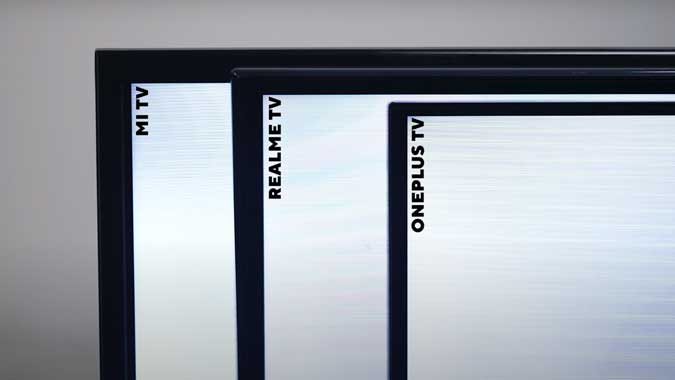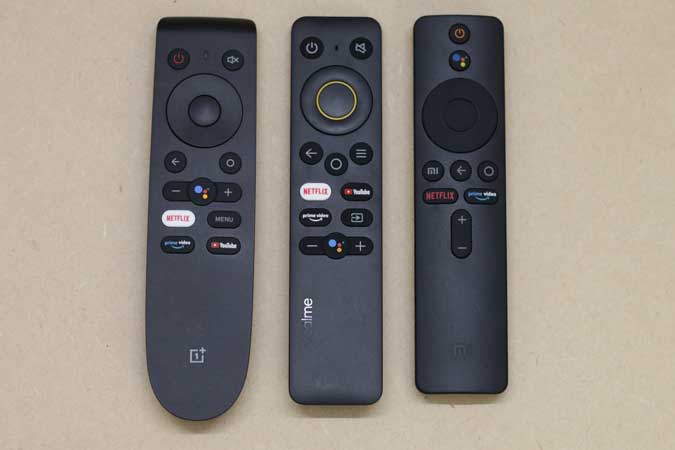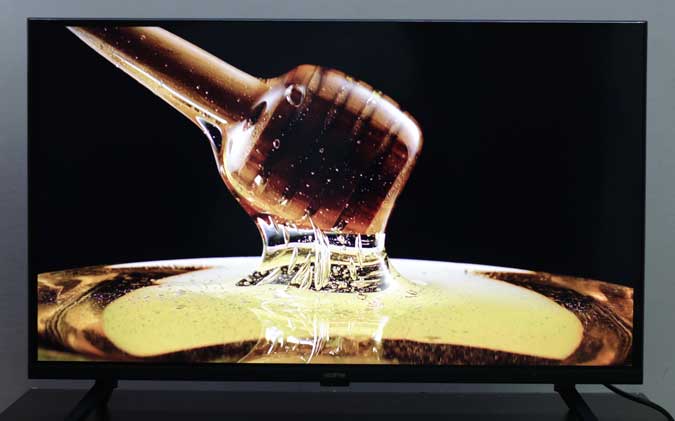The budget smart TV segment is full of choices and things can get confusing really fast. I’ve been testing the 32″ models from OnePlus Y Series 32 inches, Realme TV, and Mi TV 4A Pro, the three most popular in this price range. In this comparison article, I’ll help you make a decision on which Smart TV you can take home. Let’s begin.
Mi TV 4A PRO vs OnePlus TV vs Realme TV
I’ll compare the three TVs on parameters which you should look out for when shopping for a TV such as Display quality, sound quality, remote, ports, etc. For each parameter, I’ll choose a winner that wins in that segment and tally the results at the end. The TV with the most points would get my recommendation.
Box Contents
When you unbox the three TVs, you get a few pages of documentation, a remote, 2xAAA batteries, 2xfeet stand, and the TV with the power cord attached to the back. None of the TVs get a wall-mount and this makes this round a tie.
Winner: Tie

Ports and Connectivity
When you look at the back of the TVs, you’d find a similar configuration of ports on the back. I’ll start with the ports that are common across all the three TVs, you get an RCA port to connect old DVD players, an RF port to attach an antenna, 2xUSB 2.0 ports for connecting hard disks and Pendrive, and the Ethernet port.
OnePlus is the only TV among the three that only has two HDMI ports and the other two Realme and Mi have three HDMI ports. While it is not a big deal but if you ever want to connect or replace a device, unplugging the device from the back is a hassle, especially if you wall-mount the TV.
Apart from this, Xiaomi has a headphone jack, OnePlus sports a SPDIF port for optical audio connectivity, and Realme has a digital audio port. In the end, it all comes down to personal preference and the audio setup that you have.
Winner: Realme and Mi

Mi TV’s Port Array
Build Quality
There isn’t a stark difference in the build quality of the TVs as all of them have a similar design with an aluminum back that houses all the electronics and the display. The feet stand are plastic on the three TVs and the only noticeable difference is the bezels on the TVs. Xiaomi has the traditional outer bezels that look significantly chunkier than Realme and OnePlus. OnePlus, however, takes the cake here with the slimmest outer bezels that look modern and stylish.
Winner: OnePlus

Remote
The remotes that come with the OnePlus, Realme, and Mi all have similar design profile and buttons that make the decision a little difficult. All three remotes have a D-Pad, sponsored Netflix and Prime Video buttons, navigational keys, and a power button. I would like to point out that Mi, loses the mute button on its remote which a minor inconvenience for me.
However, I personally prefer the OnePlus remote for ergonomics as it is a little bigger than the other two and fits in the hands. On the other hand, Realme offers a remote that also has an additional IR blaster that makes the TV compatible with Universal remotes.
Winner: Realme

Audio
Realme has a 24W four-speaker array that offers a louder and richer sound when compared with 20 W speaker OnePlus and Mi TV 4A Pro. All of the three TVs support Dolby Audio so your experience will be a little better but Realme wins this.
Winner: Realme

Display
The display quality of a TV is the most important factor to take into consideration when shopping for a TV. As this is the budget segment, the TV panels used in all three TVs are sub-HD IPS-LCD panels with a resolution of 1366×768 and a 60Hz refresh rate.
The blacks are not completely dark and are always illuminated by the backlit LEDs that are common with all three TVs. However, Realme has a peak brightness of 400 nits which look a tad brighter than the other two TVs.

OnePlus TV
The color reproduction of all three TVs is similar, the reds and blues are intentionally oversaturated to make the display appear more vivid but that takes away the natural tone of the object’s skin. As OnePlus claims that they use 93% of DCI-P3 color gamut rather than the standard sRGB, it still doesn’t make a perceptible difference in picture quality.

Realme Smart TV
Mi, on the other hand, has the most responsive display among the lot and minimizes screen tearing and ghosting where Realme and OnePlus struggle, a lot. I guess no display has all the three features and makes this round a tie.
Winner: Tie
Software and Performance
The three TVs run a stock Android TV 9.0 out of the box with no customization. The user interface and experience are exactly the same and you won’t be able to tell the difference in a blind test. This is also partially true because all the TVs have a similar ARM Cortex A53 Quad-core processor with 1GB RAM, and 8GB internal storage.
However, Mi does have some personal touches that add a Pin Lock to the TV and Patchwall. Similarly, OnePlus TV has the OnePlus Connect app which is a modified version of the Android Remote app with a few additional features like the ability to use smartphone keyboard, take screenshots, and power the TV ON/OFF.
Winner: Tie

Which one should you buy?
If we tally the scores from above, Realme wins as it not only offers better remote and better sound but also has significantly better display compared to OnePlus and Mi TV 4A Pro. However, I should mention that the other two TVs are still good products and you can’t go wrong with any of the three TVs. Which Smart TV are you looking to buy? Let me know in the comments below or reach out to me on Twitter.
Buy OnePlus Y Series 80 cm (32 inches) on Amazon
Buy Realme 80cm (32 inches) on Flipkart
Buy Mi 4A PRO 80 cm on Amazon